Aerospace Industry Warranties:
In an industry that puts a premium on safety and reliability, warranty costs rarely stray far from the baseline. And while many aviation companies cope with the double whammy of rising warranty costs and declining sales, some such as Boeing and Gulfstream are actually seeing sales rise and claims fall.
The current recession has had a surprisingly mild effect on the makers of aircraft and their suppliers. Although air travel is down and many airlines are still waiting for the newest generations of commercial jets to hit the market, two of the three top American brands actually saw sales increases in the first half of 2009.
There have, however, been plenty of instances where sales fell. Of the 52 U.S.-based aerospace manufacturers that have reported their product sales figures for both the second quarters of 2009 and 2008, 38 have seen sales decreases and only 14 saw increases. But only 15 of those sales decreases were over 25%, and only five of those were over 50%. So it hasn't been as devastating as the contractions in the new home or recreational vehicle sectors.
Of the 42 U.S.-based aerospace companies that publish enough data in their financial statements to enable us to calculate warranty claims rates for both the quarters ending in June 2009 and June 2008, 25 saw their claims rate increase and 17 saw their claims rates decline. However, only 14 of those same 42 companies increased their accrual rates, while 28 reduced their accrual rates. Two of those 28 reduced their accrual rates all the way to 0%.
Annual Declines
All U.S.-based aerospace manufacturers reported $446 million in claims paid during the first quarter of 2009 and $379 million during the second quarter of 2009. Both figures are significantly below their year-ago levels. Figure 1 details the claims paid per quarter and Figure 2 calculates the warranty claims and accruals as a percentage of product revenue.
Figure 1
U.S.-based Aerospace Manufacturers
Warranty Claims Paid per Quarter, 2003-2009
(in US$ millions)

As Figure 1 details, the claims total for the second quarter of 2009 was the lowest quarterly figure seen in three years. However, because sales have also declined, the figure for claims as a percentage of sales has recently risen significantly above the 1.0% level, after spending all of 2005-2007 below that mark and most of 2008 very close to it.
OEMs vs. Suppliers
Figure 2 splits the field of 52 companies into two groups: airframe makers (OEMs in automotive parlance) and their suppliers. There are only five airframe makers reporting warranty expenses, so most of the aerospace manufacturers we're tracking are suppliers. What's interesting about the data in Figure 2 is that the claims rates of these two groups have more or less converged at the 1.03% level. That is definitely not the case in automotive or computers, where a significant gap in warranty cost remains in place between the OEMs and their suppliers. Here, the lack of a gap may have lots to do with the way parts are carefully tracked in the aviation industry, which in turn makes it easier for airlines and OEMs to bill suppliers.
Figure 2
U.S.-based Aerospace Warranty Providers
Average Claims Rates of Airframe Makers
and Their Suppliers, 2003-2009
(claims as a percentage of product sales)

Note also that the general trend in Figure 2 for both the airframe makers and their suppliers has been upwards for the past ten quarters or so. Some of this is caused by sales declines, but some is caused by the claims increases seen in Figure 1. Still, even 1% is towards the low end of the spectrum when it comes to industry average warranty costs. However, as we shall see in the next set of slides, the crossover between increasing claims and decreasing sales has been far from uniform across the aviation industry.
Boeing Is Up; Boeing Is Down
Boeing is by far the biggest U.S.-based airframe manufacturer, though within this small group it has the lowest claims cost as a percentage of sales. In Figure 3, the claims rate for the first half of 2009 is only 0.72%, based on claims of $122 million and commercial aviation sales of $17 billion. That sales figure, by the way, is up 2% from a year earlier. So despite what one would intuitively have expected sales to do, given all the financial trouble of the major airlines, Boeing's commercial jet sales inched up in the first half of 2009, at least in dollar terms.
Figure 3
Boeing Co.
Warranty Claims & Accrual Rates, 2003-2009
(as a percentage of product sales)
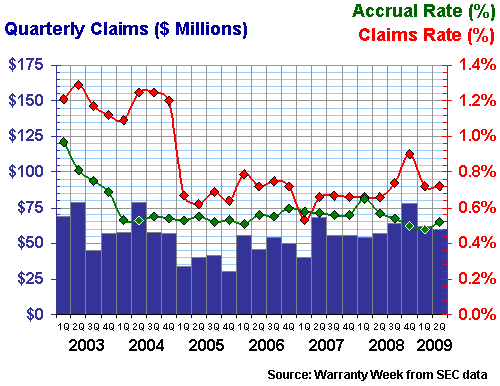
Boeing's claims rate (red line) rose too, but only slightly. As mentioned, it stood at 0.72% in June 2009. In June 2008, it was 0.66%, so the increase would have been lost as a rounding error had we not stretched the measurement out to hundredths of a percentage point. The company's claims rate has generally remained within the 0.6% to 0.8% range for most of the past four-and-a-half years, except for a slight spike seen at the end of 2008.
Meanwhile, Boeing's accrual rate (green line) actually fell slightly over the past year, from 0.57% in June 2008 to 0.52% in June 2009. However, Boeing's accrual rate was actually below 0.5% at the end of 2008, and it stayed below that level during the first quarter of 2009. And while accrual rates flirted with the 0.5% level briefly at the end of 2005, they never before fell below it. So that represents a new low tide marker for the company, and one we hope they can remain below.
Warranty cost data is not released by Europe's Airbus or by Canada's Bombardier, so the only other major commercial passenger jet maker that published any warranty data is Brazil's Embraer. We included a warranty snapshot of Embraer in the July 5, 2007 profile of ten international warranty providers, in which the company's warranty costs seemed to have settled around the 1.0% level. That's slightly above Boeing's level, but is very close to the baseline formed by General Dynamics' Gulfstream unit.
Gulfstream Sales Increases
At General Dynamics, commercial aviation is a much smaller component of overall sales than is the case at Boeing, while military sales is a much larger component. But much like Boeing, both civilian and military sales increased at General Dynamics during the first half of 2009.
The commercial warranty expenses charted in Figure 4 arise primarily from sales of Gulfstream business jets. Once again, an observer would intuitively believe that sales must have fallen in 2009, given the effects of the recession on the customer base. But although both earnings and operating margins were down in the Gulfstream segment, sales were actually up.
Figure 4
General Dynamics Corp.
Warranty Claims & Accrual Rates, 2003-2009
(as a percentage of product sales)
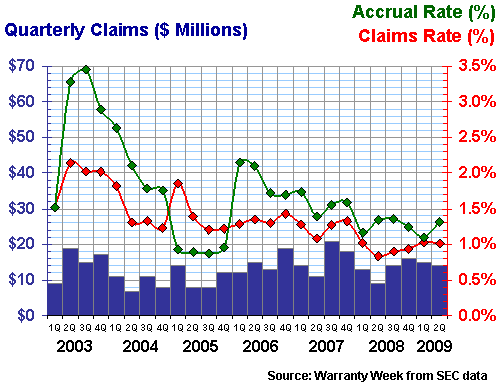
In Figure 4, it's also apparent that warranty costs are on a downward trend at Gulfstream. However, from June 2008 to June 2009, the claims rate actually rose from 0.8% to 1.0%. Over the same period, the accrual rate fell from 1.34% to 1.32%. Once again, we have to stretch the measurements out to hundredths of a percentage point to avoid losing the net change in a rounding error.
The point is, compared to the devastating sales declines and painful warranty cost increases documented for the automotive, computer, and housing industries in the last handful of weekly newsletters, things haven't been that bad for at least the major airframe makers over the past year. And although the year-ago comparisons for Boeing and Gulfstream may not be all that good, the tags "not so bad" and "been worse" are certainly suggested by the data in Figures 3 and 4.
Textron Trouble?
And then there's Textron. Though it's only 60% aviation (Cessna was 32% of 2009 sales, and Bell Helicopter was another 28%), those Cessna sales were down more than two-thirds during the first half of 2009 (helicopter sales were actually up 11%). And that massive decline in private plane sales helped Textron's overall sales of manufactured (and warranted) products decline 30% overall.
One could almost conclude that while the airlines (Boeing), corporations (Gulfstream), and the military (both) kept buying in 2009, the wealthy hobbyist aviators (Cessna) did not. So does that echo the pattern seen in automotive, where sales of recreational vehicles were especially hard-hit but sales of vocational vehicles were not? In other words, while the wealthy consumers may have cut back heavily, the transportation companies did not.
Those wealthy amateur pilots did, however, continue to demand that their small private planes be fixed by Cessna under warranty. And so did the customers of Textron's other business units. In Figure 5, a noticeable spike is apparent in recent warranty claims rates, jumping from the baseline of 1.5% seen over most of the past six years to the new high water mark of 2.5% seen in the first two quarters of 2009.
Figure 5
Textron Inc.
Warranty Claims & Accrual Rates, 2003-2009
(as a percentage of product sales)
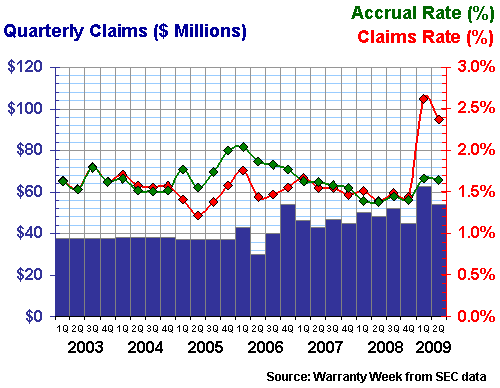
It would be comforting if that spike was almost totally caused by declines in sales. However, claims themselves also jumped, from $98 million paid out in the first half of 2008 to $117 million in the first half of 2009. Accruals, meanwhile, fell from $97 million in the first half of 2008 to $81 million in the first half of 2009. But sales fell a little bit faster than that, so the accrual rate actually rose from 1.4% to 1.6%.
Meanwhile, the combination of increased claims and decreased accruals had a noticeable effect on Textron's warranty reserve. The balance fell from $310 million at the end of June 2008 to $243 million at the end of June 2009, a contraction of $67 million. That also means the company, which used to keep its reserve balance equal to what it paid in claims over 18 to 24 months, now has reserves to pay only slightly more than a year's worth of claims.
Not All Aviation?
The problem is, only 60% of Textron's sales are aviation-related. And an unknown percentage of those warranty costs are aviation-related. So while it's probable that more than half of Textron's warranty claims belong in the aviation category, some also belongs in automotive. And it's entirely possible that the recent cost increases came out of those units rather than Cessna or Bell.
It's the same problem one faces when looking at other conglomerates such as General Electric and United Technologies. They report only one set of figures for all their company-wide warranty costs, so it's impossible to chop it up into appliances, medical equipment, jet engines, turbines, or elevators, without resorting to guesswork. We know how much revenue is aviation-related, but we have no idea if the same percentage of warranty costs are aviation-related.
United Technologies has also reduced its warranty reserve fund balance by a massive amount in the past year. The company's warranty reserve as of June 2009 stood at $1.078 billion, down from $1.237 billion at the end of June 2008. But that figure includes not only the Sikorsky, Pratt & Whitney, and Hamilton Sundstrand aviation-related units, but also the Carrier and Otis non-aviation units. So as you look at the sustained decline pictured in Figure 6, keep in mind that it may have more to do with trends in heating and cooling apparatus than with jet engines or avionics.
Figure 6
United Technologies Corp.
Warranty Claims & Accrual Rates, 2003-2009
(as a percentage of product sales)
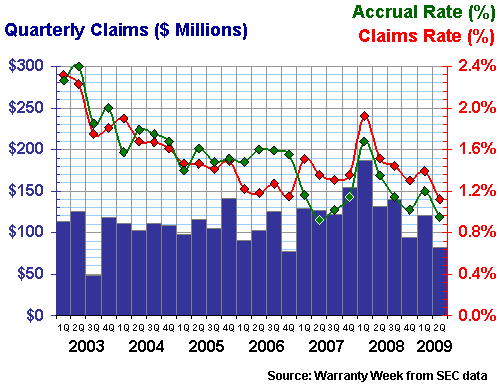
Still, what a decline it is. Claims are down from $318 million in the first six months of 2008 to $202 million in the first half of 2009. Accruals fell from $285 million to $170 million over the same period. The claims rate fell from 1.5% to 1.1%, and the accrual rate fell from 1.4% to 0.9%. The percentages would have fallen even more were it not for a 15% company-wide product sales decline.
Look a bit more closely at that sales decline, however, and it's clear that it had more to do with Carrier and Otis than with Pratt�& Whitney, Hamilton Sundstrand, or Sikorsky. While the non-aviation units accounted for just under 60% of sales in the first half of 2008, their combined sales fell by 21% in 2009. While the aviation units accounted for just over 40% of sales in 2008, their sales fell only 5.4% during the first six months of 2009. If this trend keeps up, soon a majority of United Technology's revenue will be aviation-related.
Moog and Garmin
Finally, we wanted to check in with a pair of companies that have appeared in three of our last four roundups of warranty trends in the aerospace industry. Snapshots of Moog Inc. were included in the April 9, 2009 and July 24, 2008 newsletters. And a snapshot of Garmin Ltd. was part of the October 2, 2007 newsletter.
As we noted in the April 9, 2009 newsletter, Moog Inc. opened for business in 1951 as a supplier of aircraft and missile components such as the electro-hydraulic servo valve, used on fighter aircraft and guided missiles during the Cold War. Robert A. Moog, inventor of the electronic synthesizer that bears his name, was a cousin of the company's co-founders, brothers William C. Moog and Arthur Moog.
Back in April, we observed that both claims and accrual rates had taken a turn upwards at the end of 2008. Now, with six months more of data, we're sad to report that the claims rate has accelerated its ascent while the accrual rate has dove to its lowest level ever (at least since reporting began in 2003).
Figure 7
Moog Inc.
Warranty Claims & Accrual Rates, 2003-2009
(as a percentage of product sales)
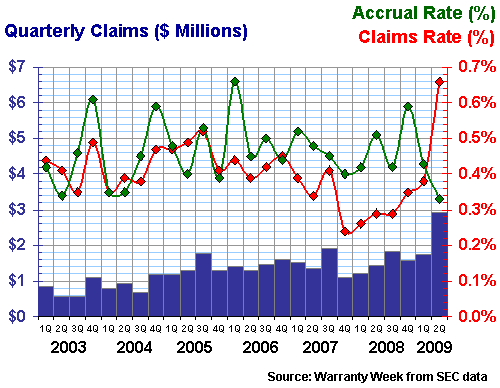
As is apparent in Figure 7, both claims and accrual rates have now both gone to new extremes. The claims rate rose from 0.29% to 0.66% during the past year, while the accrual rate fell from 0.51% to 0.33% over the same time period. Sales in the second quarter fell 10% to $445 million, so that accounts for some of the change. But claims rose from $2.6 million to $4.7 million while accruals fell from $4.5 million to $3.4 million. Let's hope it's just an anomaly and that the company soon returns to the predictable course it followed from 2003 to 2007.
Hand-Held Computer Company?
Garmin isn't really an aviation supplier at all. In fact, it's probably more at home when counted as a consumer electronics company, since it sells satellite-based navigation system to car drivers through outlets such as Best Buy. In fact, one of its newest products is an AT&T smart phone with built-in navigation functionality. But Garmin also makes cockpit systems and avionics, so there is still some basis for counting it as an aerospace manufacturer.
We always note in the computer industry warranty snapshots how manufacturers of hand-held devices such as Palm Inc. seem to suffer unusually high warranty costs. We suspect that's also a problem for some of the other smart phone vendors. And, as a quick glance at the data in Figure 8 suggests, it's becoming a major problem for Garmin as well.
Figure 8
Garmin Ltd.
Warranty Claims & Accrual Rates, 2003-2009
(as a percentage of product sales)

During the first three months of 2009, Garmin spent $42.6 million on warranty claims while bringing in $436.7 million in revenue. That's a 9.7% claims rate. And while the claims quickly fell back to $20 million in the second quarter (against sales of $669 million), and the claims rate returned to a more manageable 3% level, this is the second time Garmin has seen its warranty costs exceed 5% of sales.
It may be nothing to worry about. After all, Palm has survived for multiple years with its claims and accrual rates both above 5%. High warranty costs may just be a fact of life at the smart end of the hand-held device industry. The problem is, during the same quarter that Garmin spent $42.6 million on warranty claims, its net income was only $48.5 million, and earnings per share fell 64% from 2008 levels. Let's hope shareholders don't soon realize there's a connection between those high repair costs and the low earnings.
| Part One: Top 100 Warranty Providers |
| Part Two: Automotive Industry |
| Part Three: Computer & Disk Drive Industries |
| Part Four: New Home Builders |
| Part Five: Aerospace Industry |
| Part Six: Medical Equipment & Scientific Instruments |
| Part Seven: Telecom & Data Networking Equipment |
| Part Eight: HVAC, Appliances & Building Materials |








